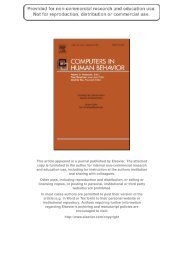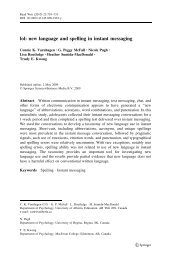Six Models for the Internet + Politics
You also want an ePaper? Increase the reach of your titles
YUMPU automatically turns print PDFs into web optimized ePapers that Google loves.
Archon Fung, Hollie Russon Gilman, and Jennifer Shkabatur 37<br />
FIG 4. Direct Digital Democracy<br />
in providing public services and solving public problems that require continuous<br />
commitment and actions.<br />
Direct Digital Democracy (Model 3)<br />
As <strong>the</strong> beginning of <strong>the</strong> digital age, many scholars 14 and practitioners 15 have<br />
thought that a central contribution of <strong>the</strong> new ICTs to democracy would be to<br />
create direct connections between citizens on one hand and politicians and policy<br />
makers on <strong>the</strong> o<strong>the</strong>r. On this view, ICT takes out <strong>the</strong> “middle men”—<strong>the</strong><br />
intermediaries of traditional organizations and media—between citizens and government<br />
and so ushers an era of direct and participatory digital democracy as<br />
depicted in Figure 4.<br />
The difficulty with this view is that, again, it is inattentive to individual incentives<br />
and institutional imperatives. ICT has great potential to enable citizens to<br />
communicate directly with government. This has been true <strong>for</strong> some time. 16 But<br />
that potential remains largely unrealized because most policy makers and politicians<br />
have little incentive to create direct digital democracy. In o<strong>the</strong>r words, <strong>the</strong><br />
failure to realize e-democracy is not in <strong>the</strong> first instance a technological problem,<br />
but a political one. Solutions, <strong>for</strong> those desiring greater direct e-democracy,<br />
require political innovations much more than technological ones.<br />
A recent study of websites operated by <strong>the</strong> 75 largest American cities demonstrated<br />
that <strong>the</strong> majority of <strong>the</strong>m provides citizens with ample public in<strong>for</strong>mation—contact<br />
in<strong>for</strong>mation <strong>for</strong> public officials, description of <strong>the</strong> activities of<br />
municipal departments, online council agenda minutes, downloadable <strong>for</strong>ms,<br />
etc. However, municipal web sites only rarely contain more than such<br />
“billboard” in<strong>for</strong>mation (Mossberger, Wu and Jimenez 2010). The explanation,<br />
of course, lies in political incentives ra<strong>the</strong>r than technological barriers. Most politicians<br />
do not offer rich modes of digital exchange with <strong>the</strong>ir constituents,<br />
clients, and citizens because policy makers see little gain, and perhaps much<br />
risk, in that exchange.<br />
Recently, we have seen both <strong>the</strong> Obama White House and a number of administrative<br />
agencies implement richer tools <strong>for</strong> dialog with and feedback from citizens.<br />
Shortly after Obama’s election, <strong>for</strong> example, <strong>the</strong> White House web site<br />
featured an “Open For Questions” process in which users could nominate questions<br />
to ask <strong>the</strong> president and vote on <strong>the</strong> importance of questions that o<strong>the</strong>rs<br />
14<br />
See, <strong>for</strong> example, Ben Barber’s discussion of “teledemocracy” in Strong Democracy (1984, pp. 275). See also,<br />
Rheingold (2002); Shane (2004); Coleman and Blumler (2009).<br />
15<br />
See e.g., Noveck (2009, p. 517); O’Reilly (2010).<br />
16<br />
See, <strong>for</strong> example, Benjamin Barber’s discussion of teledemocracy in his Strong Democracy (1984).
















